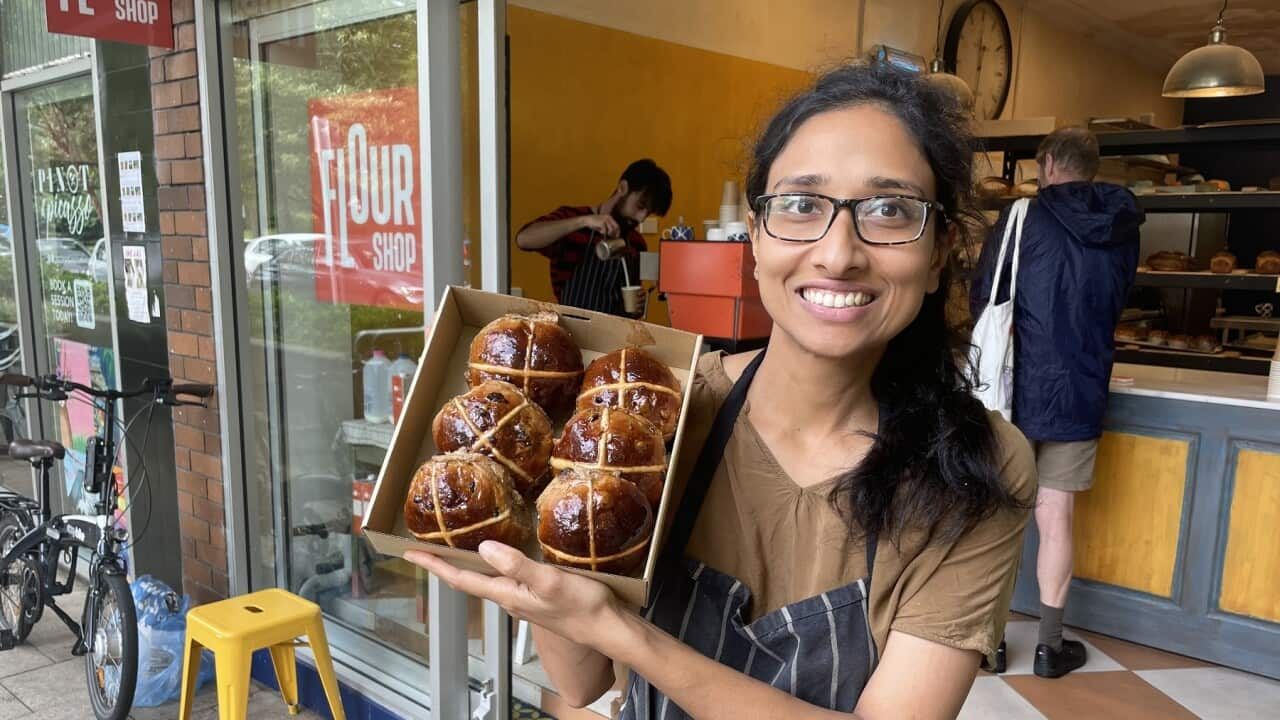Highlights
- Good Friday is the most sacred day on the religious calendar for Maronite, Chaldean and Melkite Catholics
- Maronite Catholics break their fast at midday with a traditional soup
- The “monk’s soup” recipe contains no meat or fat and dates from the fourth century
Translating as “monk’s soup” (called kibet el rahib in Arabic), the broth’s recipe is believed to date back to the fourth century CE and was first prepared in the mountains of Lebanon by exiled Maronite priests.
The simple, rustic broth consists of little wheat balls in a soup with lentils, spinach, lemon, herbs and garlic.
It is usually prepared by elder female members, including grandmothers, to be shared with their extended families at lunch time on Good Friday to break a fast from midnight to midday.
The soup and wheat balls must be prepared with no meat or fat and lots of green vegetables. Ramona Mourad said she and her seven siblings had been descending on their mother’s Merrylands home every Easter Thursday to prepare the soup as well as a special pumpkin “kibbi” bake (similar to a quiche) for as long as she could remember.
Ramona Mourad said she and her seven siblings had been descending on their mother’s Merrylands home every Easter Thursday to prepare the soup as well as a special pumpkin “kibbi” bake (similar to a quiche) for as long as she could remember.

A dry bake made from vegetables is often served with monk's soup. Source: Sylvana Sahyoun
Using two, 20-litre pots, the siblings combine masses of coriander, garlic and lentils with water (spinach is added later) to form the soup.
They then hand-roll 1000 wheat balls which are added to the soup half an hour before it is served on Good Friday. The accompanying “kibbi” bake consisted of pumpkin, potato and hummus and was also prepared on the day before Good Friday, she said.
The accompanying “kibbi” bake consisted of pumpkin, potato and hummus and was also prepared on the day before Good Friday, she said.

Rolling the wheat and flour balls for the soup must be done the day before Good Friday. Source: Sylvana Sahyoun
At 96 years of age, their mother, Adelle Raad, was content to supervise proceedings these days, Mrs Mourad said.
We have to make enough soup and bake for around 80 people.
“On Good Friday, we attend the 14 stations of the cross around Parramatta organised by our church, Our Lady of Lebanon," she said. “We then go back to Mum’s and wait until midday to break our fast. Later, at 3pm which was the time Jesus was crucified, we all attend Mass at the church.”
“We then go back to Mum’s and wait until midday to break our fast. Later, at 3pm which was the time Jesus was crucified, we all attend Mass at the church.”

The finished monk's soup is a simple yet filling Good Friday meal. Source: Ramona Mourad
On Thursday, Sylvana Sahyoun, who also attends Our Lady of Lebanon Church in Harris Park, was busily preparing monk's soup, also known as the kibbeh of the monks, for around 30 family members including her grandchildren and great-grandchildren. She said more than 5000 worshippers would attend services in and around the church on Good Friday with the 14 stations of the cross procession being a very emotional event.
She said more than 5000 worshippers would attend services in and around the church on Good Friday with the 14 stations of the cross procession being a very emotional event.

Sylvana Sahyoun prepares monk's soup for Good Friday every year. Source: Sylvana Sahyoun
People wear black and there is a lot of crying but it's beautiful and touching.
Mrs Sahyoun, who is also the co-ordinator, will welcome three generations of her family on Good Friday as well as for a big feast on both Easter Sunday and Easter Monday.
"On Good Friday, we sacrifice, and we deprive ourselves of luxury and we eat simple foods. That's why we prepare such a simple dish for this day," she said.
Good Friday messages from religious leaders
Archbishop Antoine Charbel Tarabay, head of the Maronite Catholic Eparchy of Saint Maroun of Australia, New Zealand and Oceania said Good Friday was the summit of Christian life commemorating the crucifixion of Jesus and his death at Calvary.
"It is observed during Holy Week as part of the Paschal Triduum. It is also known as Holy Friday or Great Friday," he said. “With the mystery of the cross, we contemplate the mystery of reconciliation and mercy. The cross is a revolution of love, reconciliation and mercy in a world that yearns for peace.”
“With the mystery of the cross, we contemplate the mystery of reconciliation and mercy. The cross is a revolution of love, reconciliation and mercy in a world that yearns for peace.”

Bishop Antoine-Charbel Tarabay, the first Maronite Archbishop of Australia, New Zealand, and the other countries of Oceania. Source: Bishop Antoine-Charbel Tarabay
The Archbishop explained that the mystery of the cross reconciles man with God, self and the other, saying: "The cross revealed to us the true meaning of our existence because we were given the grace of life from the Lord who came so that we might have abundant life."
He said Good Friday was an invitation to kneel before the holy cross, which has transformed pain and death into an instrument of salvation and new life.
He explained that there was no answer without contemplating the great love of God that was manifested in the incarnation, the cross and the resurrection:
“In the cross we really see the love of God that gave itself,” he said.
“The cross is an instrument of salvation and victory. We prostrate before the cross and bear witness to the truth, even if this testimony leads us to the cross.”
Father Melhem Haikel from St Rita's Melkite Catholic Church in Liverpool, NSW, told SBS Arabic24: “Good Friday is a Friday of pain, but at the same time it is a Friday of joy because it is full of hope"
"All of humanity together is going through these difficulties and pains, especially when we see the drums of war, the drums of epidemics, and the problems of weak love. This is all kind of a pain. But we must not lose hope and joy, as Jesus taught us.”
He told SBS Arabic24 that he had two messages: one for the world and another for Christians.
“For the world, we need peace today and we need a bond of brotherhood between each other because we are all human and we are linked by human brotherhood. We hope that this Good Friday will be a source of light and peace for the whole world," Father Heikel said.
"For the Christian faithful, I say, return to your unity, and return to your love, because you are all part of one body."
Father Thaer Alsheikh from Our Lady Guardian of Plants Chaldean Catholic Church told SBS Arabic24: "Good Friday is a celebration once a year in which we remember the reconciliation for the sin that caused man to lose his image with Adam and Eve."
"Good Friday is an important occasion for Christians, especially since the faithful has to go to church, and therefore most countries have made this day an official holiday. This day is not a day for buying and selling, it is a spiritual day, not a worldly day."
There are fewer than 37,000 Maronite Catholics living in Australia, according to the 2016 Census.
It’s a tiny figure when compared to the country’s wider population of 'Western Catholics', which sits around 5.2 million or 22 per cent of the population.
Interestingly, and according to the “Encyclopedia of the Peoples of Africa and the Middle East”, the Maronite diaspora of over 2 million individuals is double that of the Maronite population still living in their historic homelands of Lebanon, Syria, and Israel.


